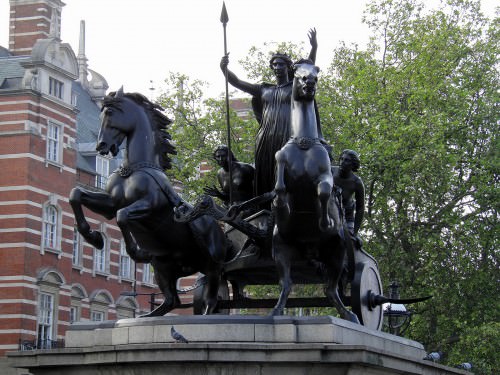
Queen Boudica
Boudicca was the Celtic Queen of the Iceni tribe of modern-day East Anglia, Britain, who led a revolt against Rome in 60/61 AD.
The Iceni King, Prasutagus, an independent ally of Rome, divided his estate between his daughters and Emperor Nero of Rome. When Prasutagus died, however, his lands were taken by Rome and the Iceni lost their status as allies. When his wife, Boudicca, objected to this action she was flogged and her two daughters raped. She mounted a revolt against Rome which left the ancient Roman cities of Camulodunum ( Colchester, today ), Londinium ( London ) and Verulamium ( modern city of St Albans in Hertfordshire ) in ruins and over 80,000 Roman citizens of Britain dead.
She was defeated at the Battle of Watling Street by the Roman Governor Gaius Suetonius Paulinus. Boudicca is said to have committed suicide by poisoning herself after her defeat.
The primary sources of the story of Boudicca's revolt are the Roman historians, Publius Cornelius Tacitus (56-117 AD) and Cassius Dio (150-235 AD). These two offer different versions of the story in that Tacitus claims the revolt sprang from the ill treatment of the Iceni following Prasutagus' death while Dio writes that the cause of the uprising was a dispute over a loan.
Tacitus' account is generally accepted as being more factual because his father-in-law, Gnaeus Julius Agricola (40-93 AD) was the governor in Britain chiefly responsible for the successful conquest of the region and served as Tacitus' primary source of information. There is no doubt of Agricola's participation in the suppression of Boudicca's revolt.
Boudicca first struck the city of Camulodunum (modern Colchester) where she massacred the inhabitants and destroyed the settlement. Governor Suetonius and imperial agent Catus Decianus sent a lightly armed force of 200 men of The Ninth Roman Division, led by Rufus, marched to relieve the settlement.
Suetonius, returning from Mona, marched to Londinium (modern London) but, Boudicca's army sacked Londinium and, as before, massacred the inhabitants.
Suetonius had offered the people of the city safe passage with his army and it seems many accepted this offer. However, Tacitus writes, "but those who stayed because they were women, or old, or attached to the place, were slaughtered by the enemy. Verulamium suffered the same fate."
While the Britons were destroying Verulamium (modern St. Albans) Suetonius decided to destroy them in a final battle: the Battle of Watling Street. Boudicca's superior numbers were of no advantage in the narrow field Suetonius had chosen.
While the site of the battle is unknown, it is referred to as The Battle of Watling Street and suggestions as to precise location range from King's Cross, London to Church Stowe, Northamptonshire. Following Boudicca's defeat, Suetonius instituted harsher laws on the indigenous people of Britain until he was replaced by Publius Petronius Turpilianus who further secured the south of the region for Rome through gentler measures.
Other, smaller, insurrections were mounted in the years following Boudicca's revolt but none gained the same wide spread support nor cost as many lives. The Romans would continue to hold Britain, without any further significant trouble, until their withdrawl from the region in 410 AD.
Though she lost her battle and her cause, Boudicca is celebrated today as a national heroine and a universal symbol of the human desire for freedom and justice.
No comments:
Post a Comment